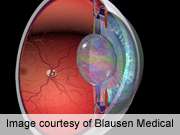Ranibizumab no better than saline for vitreous hemorrhage

(HealthDay)—For patients with vitreous hemorrhage from proliferative diabetic retinopathy (PDR), the probability of vitrectomy within 16 weeks after intravitreal injections of ranibizumab or saline is lower than expected, with little difference seen between the two treatments, according to a study published online Jan. 31 in JAMA Ophthalmology.
Abdhish R. Bhavsar, M.D., from the Retina Center of Minnesota in Minneapolis, along with colleagues from the Diabetic Retinopathy Clinical Research Network, compared intravitreal ranibizumab with intravitreal saline injections for their effect on vitrectomy rates for vitreous hemorrhage from PDR in a phase 3, randomized clinical trial involving 261 eyes of 261 participants who were at least 18 years of age and had type 1 or 2 diabetes. One hundred twenty-five eyes were randomly allocated to receive 0.5-mg intravitreal ranibizumab, and 136 were randomized to receive intravitreal saline at baseline and at four and eight weeks.
At 16 weeks, the researchers found that the cumulative probability of vitrectomy was 12 percent with ranibizumab and 17 percent with saline, and that the cumulative probability of complete panretinal photocoagulation without vitrectomy was 44 and 31 percent, respectively (P = 0.05). From baseline to 12 weeks, the mean visual acuity improvement was 22 and 16 letters, respectively (P = 0.04). Within 16 weeks, 6 and 17 percent, respectively, experienced recurrent vitreous hemorrhage (P = 0.01). Endophthalmitis developed in one eye following saline injection.
"This study suggests little likelihood of a clinically important difference between ranibizumab and saline on the rate of vitrectomy by 16 weeks in eyes with vitreous hemorrhage from PDR," the authors write. "Whether vitrectomy rates after saline or ranibizumab injection are different than observation alone cannot be determined from this study."
Genentech provided the ranibizumab and partially funded the study.
More information:
Abstract
Full Text (subscription or payment may be required)
Health News
Copyright © 2013

















